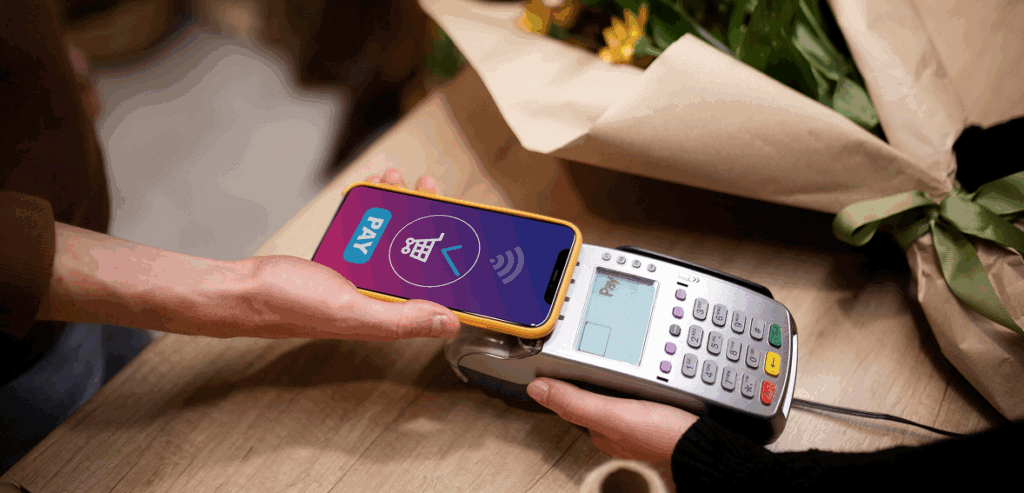
By Matilda Noble June 11, 2025
In today’s fast-changing retail and hospitality environment, speed, security, and convenience are more important than ever. Whether you run a local café, a boutique clothing store, or a full-service restaurant, keeping up with modern payment technology is essential to meeting customer expectations. EMV and contactless payments have become the new standard, and understanding them is key to staying competitive and protecting your business from fraud.
EMV technology, also known as chip card processing, and contactless payment methods such as tap-to-pay or mobile wallets are not just for big-city franchises. They’re now widely used across communities of all sizes, including small towns and regional hubs. Local businesses that fail to adapt may risk not only losing customers but also facing liability for fraudulent transactions.
What is EMV and Why Does It Matter?
EMV stands for Europay, Mastercard, and Visa. It refers to the global standard for credit and debit cards embedded with microprocessor chips. These chips generate a unique transaction code each time a payment is processed, making it far more secure than traditional magnetic stripe cards.
When a customer inserts a chip card into an EMV terminal, the chip communicates with the terminal to verify the card’s authenticity and complete the transaction. Unlike magnetic stripe transactions, which rely on static data that can be easily copied, EMV chip transactions are dynamic and nearly impossible to duplicate.
For local merchants, adopting EMV technology means enhanced protection against counterfeit card fraud. Since October 2015, liability for certain types of fraud shifted to businesses that don’t accept EMV payments. That means if your restaurant or shop is still using a swipe-only terminal and a fraudulent card is used, your business could be held responsible for the losses.
Upgrading to EMV-compatible equipment is not just about avoiding liability. It’s also about building customer trust. Many consumers are now aware of the security benefits of chip cards and prefer to shop at businesses that accept them.

Understanding Contactless Payments
Contactless payments are another major advancement in transaction technology. They allow customers to complete purchases by simply tapping their card or smartphone near a compatible terminal. This is made possible by near-field communication (NFC) technology, which transmits payment information wirelessly and securely.
There are two main types of contactless payments. One is tap-enabled credit or debit cards that carry the contactless symbol. The other includes digital wallets like Apple Pay, Google Pay, and Samsung Pay, which allow users to store their card information on their phones and use biometric authentication for added security.
For restaurants and shops, offering contactless payment options brings a range of benefits. It speeds up transactions, reduces physical contact between staff and customers, and offers a modern checkout experience. This is particularly important in environments where quick service is expected, such as coffee shops, bakeries, and casual dining spots.
Contactless payment methods also appeal to younger, tech-savvy customers who expect businesses to support mobile technology. Ignoring this trend could mean missing out on valuable sales opportunities and repeat business.
Benefits of EMV and Contactless for Local Restaurants
Restaurants in particular can gain a lot by implementing EMV and contactless payment solutions. These technologies enhance not just security but also operational efficiency. In full-service settings, pay-at-the-table EMV devices reduce the number of times a server handles a card, decreasing the chances of loss or theft and improving guest confidence.
In quick-service or fast-casual restaurants, contactless payments streamline the checkout process and allow for faster customer flow during busy hours. Reduced wait times at the register can directly improve table turnover and overall revenue.
Furthermore, accepting modern payments can create a more professional image. When guests see updated hardware and seamless technology in action, it reinforces the idea that your business is organized, forward-thinking, and invested in quality service.
EMV and contactless also work well for curbside pickup and delivery orders. Mobile card readers equipped with these technologies allow staff to collect secure payments outside the storefront, adding flexibility to your service model.

How Shops Benefit From Modern Payment Methods
Retail stores face a unique set of challenges when it comes to checkout. Long lines, fraud risk, and customer convenience are all key concerns. Adopting EMV and contactless payments helps tackle these issues head-on.
With EMV chip readers, stores gain stronger fraud protection at the point of sale. This is particularly important in categories such as electronics, jewelry, and specialty goods, where high-ticket purchases attract fraud attempts. By using EMV terminals, you reduce the chance of accepting cloned cards and becoming liable for associated losses.
Contactless payments help reduce line lengths during peak hours. Whether you’re operating a busy shop in the city or a weekend pop-up market in a rural area, faster transactions mean happier customers and more completed sales. Shoppers don’t have to fumble with wallets or pin pads—they simply tap and go.
Contactless transactions also integrate well with loyalty programs and mobile receipts. Customers using mobile wallets often receive digital records of their purchases, making it easier to track rewards and returns. For stores that rely on repeat visits and upsells, this convenience strengthens customer retention.
Addressing Common Concerns and Misconceptions
Despite the clear advantages, some businesses are hesitant to adopt EMV or contactless payment systems. Common concerns include cost, complexity, and perceived lack of demand. However, these concerns often come from outdated assumptions or lack of information.
Cost is frequently cited as a barrier, but the reality is that the price of EMV and contactless hardware has come down significantly in recent years. Many payment providers offer affordable terminal rentals or bundled software packages for small businesses. The investment you make in upgraded equipment is quickly offset by the reduction in fraud risk and improved efficiency.
Some merchants believe their customer base isn’t interested in using contactless methods. But recent trends show that even in smaller communities, usage of tap-to-pay and mobile wallets is increasing. Consumers are becoming more familiar with this technology through travel, online shopping, and large chain retailers. Offering similar capabilities helps local businesses compete on equal footing.
There’s also a misconception that EMV slows down transactions. While chip card payments are slightly longer than swiping, they are still much faster than processing a check or dealing with a declined card. Contactless payments, on the other hand, are among the fastest options available today.

What to Look for in an EMV and Contactless Provider
Not all payment service providers offer the same level of support or pricing. When choosing a provider to help your business transition to EMV and contactless payments, there are several factors to consider.
Start with compatibility. Make sure the terminals or systems offered can integrate smoothly with your existing point-of-sale setup. Whether you’re using a tablet-based POS or a full-service system with inventory and reporting features, seamless integration avoids workflow disruptions.
Support is equally important. Look for a provider with responsive customer service and clear training materials. Ideally, they should be available locally or at least offer real-time support to address technical issues that could impact your ability to accept payments.
Security features should also be evaluated. EMV and contactless systems should include end-to-end encryption and tokenization to protect transaction data. Some providers also offer tools for chargeback management, fraud detection, and reporting that can help you monitor trends and improve your operations.
Finally, consider pricing transparency. Look for providers who offer clear breakdowns of processing fees, monthly charges, and equipment costs. Avoid vendors that lock you into long-term contracts with hidden penalties.
Steps to Upgrade Your Payment System
Once you decide to adopt EMV and contactless payments, the upgrade process typically follows a few basic steps. First, assess your current system and identify what needs to change. If you’re using older hardware that doesn’t support chip or NFC transactions, you’ll need new terminals. If you already have a POS that’s partially compatible, your provider may only need to activate or configure those features.
Next, select a provider who understands the needs of small businesses. Schedule a demo or consultation to see how their equipment works and what features they offer. Ask questions about installation timelines, support during setup, and what training is included for your staff.
Once your new system is in place, train employees on how to process EMV and contactless transactions correctly. Make sure they understand how to insert, tap, or guide customers through mobile payments. Also, explain the security benefits to help them answer any questions from customers who are new to the technology.
Finally, let your customers know about the change. Place signage at your register or entrance letting people know you now accept chip and contactless cards, as well as digital wallets. This not only informs customers but also positions your business as modern and customer-focused.

How Local Businesses Can Work Together to Promote Modern Payments
As more area restaurants and shops adopt EMV and contactless payment technology, there is an opportunity for businesses to collaborate and raise awareness together. Consider partnering with other local merchants to promote mobile payments during community events or shared marketing campaigns.
Host a “tap to pay” weekend or offer a small discount for customers who use contactless methods. Work with your local chamber of commerce or small business alliance to distribute educational materials or run a group training session for merchants still learning the ropes.
These collaborations benefit everyone. They make customers more comfortable using modern payment methods and encourage broader adoption within the business community. Over time, this helps make your entire area a more attractive and forward-thinking destination for shoppers and diners.
Conclusion
EMV and contactless payments are no longer optional—they’re essential tools for today’s retailers and restaurants. For local businesses, adopting these technologies means more than just staying current. It means offering a faster, safer, and more enjoyable experience for every customer who walks through your door. From reducing fraud liability and speeding up checkout times to appealing to a broader audience, the benefits are clear. And with equipment becoming more affordable and support more accessible, there’s never been a better time to make the switch. Whether you run a cozy diner, a high-end boutique, or a weekend farmers market stall, integrating EMV and contactless payments will set you up for continued success. It shows your customers that you value their convenience, respect their security, and are ready to grow with the times.